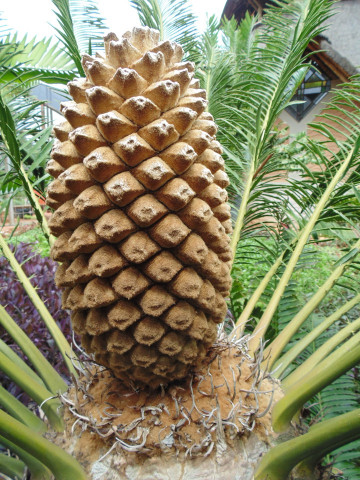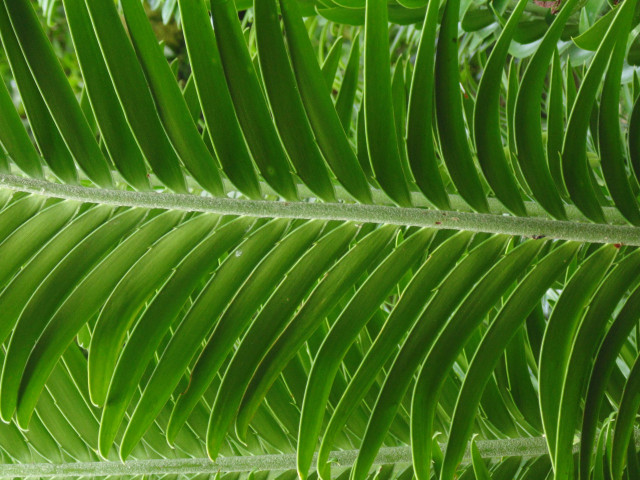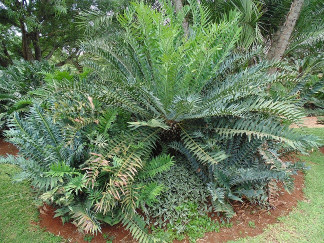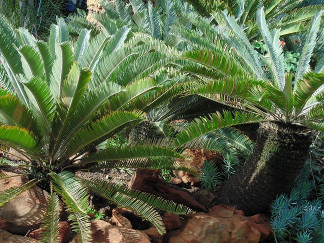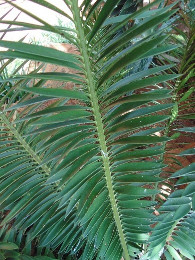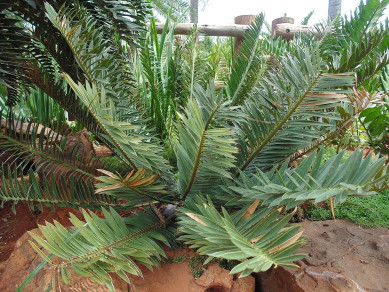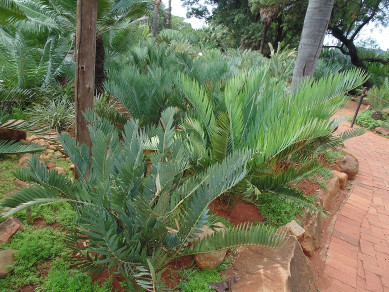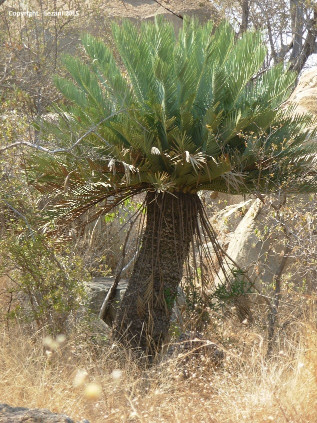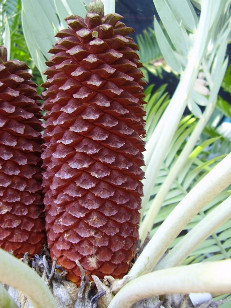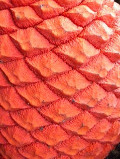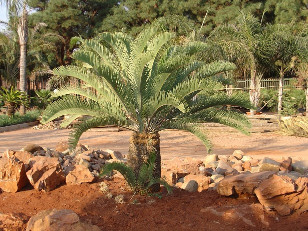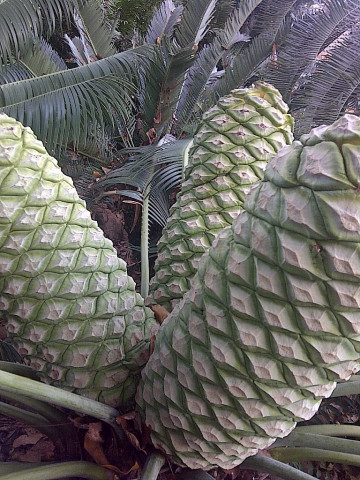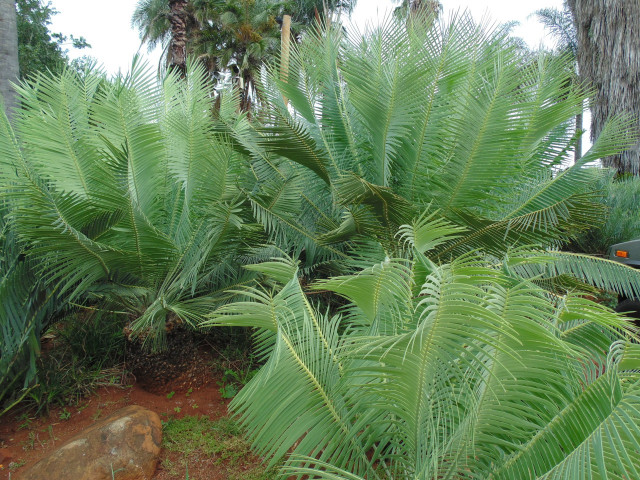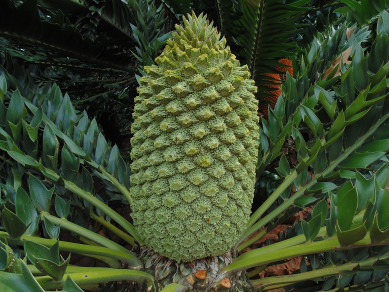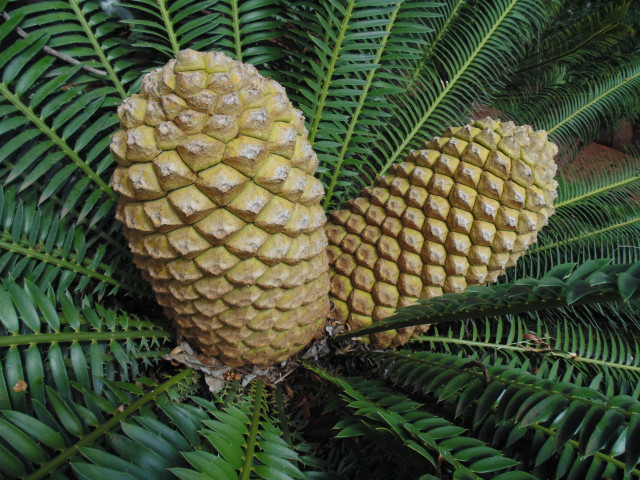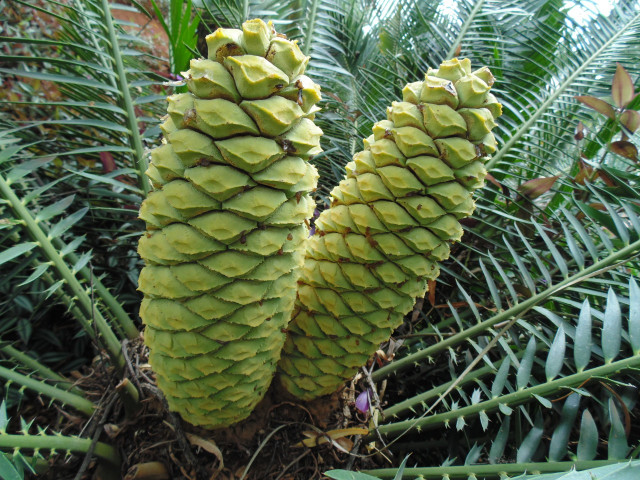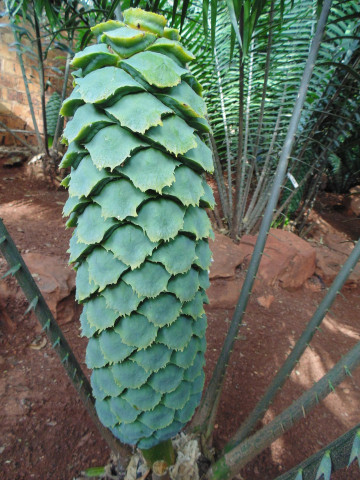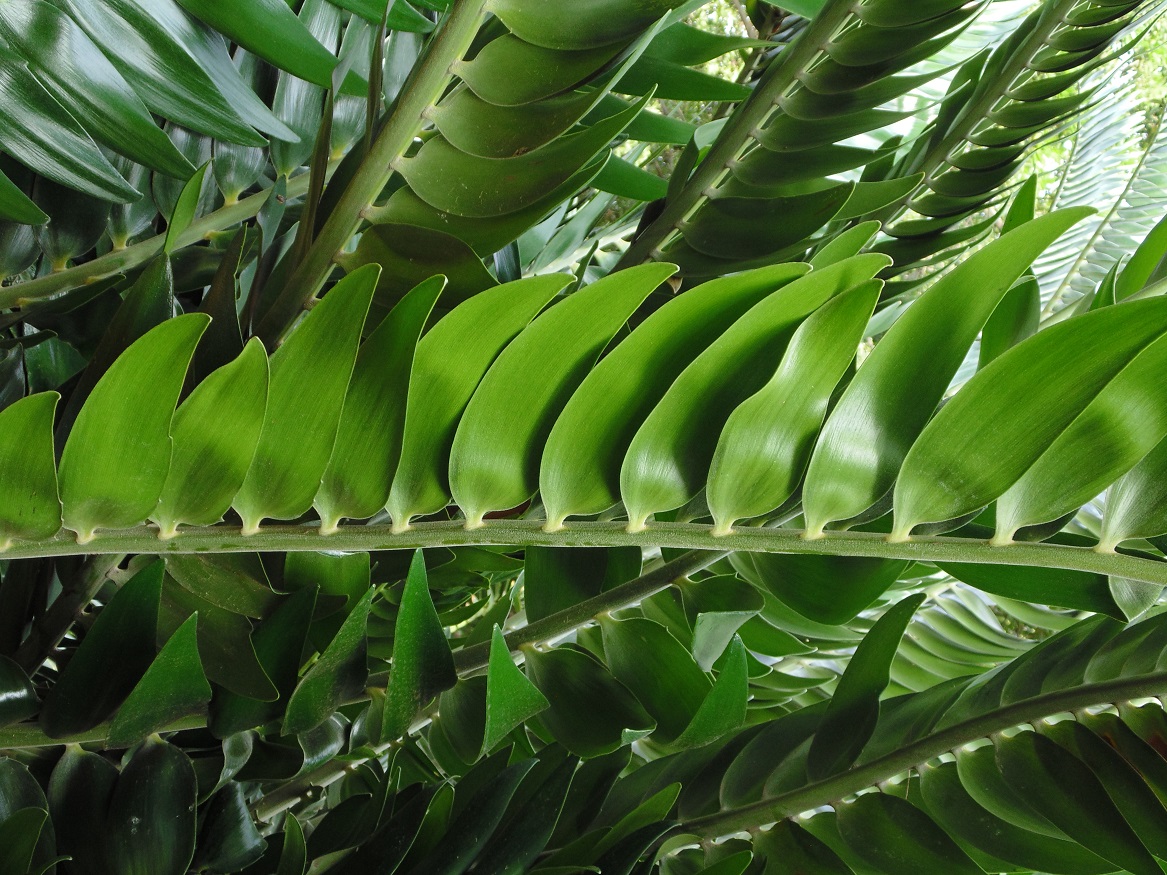LOCAL RANGE
Local Plants

Encephalartos altensteinii is a palm-like cycad in the family Zamiaceae. It is endemic to South Africa. The species name altensteinii commemorates Altenstein, a 19th-century German chancellor and patron of science.
It is commonly known as the breadtree, broodboom, eastern Cape giant cycad or uJobane (Zulu). It is listed as vulnerable due to habitat destruction, use for traditional medicine and removal by collectors.

Encephalartos aplanatus is a shade-loving cycad that closely resembles E. villosus. The leaflets of E. aplanatus, however, tend to be wider than those of E. villosus and the two species are also geographically separated. E. aplanatus is easy to grow but is not common in cultivation.
This species usually has a single subterranean stem with an exposed apex. Unlike E. villosus, E. aplanatus does not sucker. It usually produces 2 to 8 erect, arching leaves up to 3.5 m long which sag horizontally with age. Leaves have a petiole up to 200 mm long. The lower rachis is covered with a whitish indumentum. Mature leaves are dark green and glossy, the leaflets twisted and undulating. The leaflets are directed towards the apex, and opposing leaflets are at 180 degrees to each other. Lower, proximal leaflets progressively decrease in size, finally reduced to prickles. Median pinnae are up to 300 mm long, 40 mm wide, narrowly ovate, tapering to an acute tip with both margins sparsely dentate, very rarely entire.
Male plants produce up to three cones, green when young, turning yellow when mature, up to 650 mm long and 80 to 100 mm in diameter, with a peduncle up to 220 mm long. Pollen is shed from the smooth, hairless microsporophylls in mid autumn.

E.arenarius stems may be up to 1m tall, but in its habitat the lower part of the stem is usually covered by sand and leaf mold. Smaller plants often appear to have subterranean stems for this reason. The diameter of the stem is 20cm to 30cm but it may be wider at the base. The crown of the stem is covered with light-brown hair, especially before new leaves are formed. Single stems occur, but plants are more usually branched from the base to form clumps with stems of varying height. Taller stems usually lean over to one side.
The attractive leaves of E.arenarius may be 1m to 1.5m long, including a leaf stalk of 15cm to 20cm long. The rachis is recurved at the tip and the leaves are light green when they are young with a slight bloom. Older leaves become darker green in colour and the bloom disappears. In a few, probably dryer, localities a bluish-green form occurs.
The pinnae at the middle of the leaf are 12cm to 16cm long and 2,5cm to 4cm broad. The leaflets have three or four lobes on the lower margin. The upper margin is usually smooth, but may occasionally have one tooth. The lobes are in the same plane as the leaflet or slightly twisted. The lower leaflets have only one or two lobes and are reduced in size to an occasional single prickle. Seedling leaves have three lobes at the tip, with or without a tooth on the upper margin and one or two teeth or lobes or the lower margin. The leaflets overlap in the top part where they are attached to the rachis in the form of a “V”. Lower down they are more widely spaced and more spreading.
Single cones are formed. Mature cones are light green in colour and are borne on a short thick peduncle, 4cm to 8cm long. The male cone is 30cm to 50cm long and 8cm to 15cm in diameter. The scales at the middle of the cone are approximately 3.5cm long and 2.5cm wide. The beak of the scale protrudes approximately 1cm.
The female cone is barrel-shaped, 35cm to 60cm long and 20cm to 30cm in diameter. The scales at the middle of the cone are approximately 7cm long, 5cm broad and 4cm high. The face of the scale is usually four-sided with a slightly wrinkled surface and a beak which protrudes approximately 2cm. The female cone is often pushed down to an almost horizontal position by the formation of new leaves. The sarcotesta is red and shiny and seeds are approximately 5cm long and 2,5cm wide, with a fleshy beak.

The stems of Encephalartos brevifoliolatus are well developed, usually unbranched but often suckering from the base to form clumps of up to 6 stems. The stem is erect but often leaning to some extent or even hanging from cliffs. Stems are up to 2.5m tall and 250mm to 300mm thick and covered by relatively small remains of leaf bases which are often charred from fires in its grassland habitat. The crown is not woolly but cataphylls (bracts) are initially covered by a thin, whitish, felt-like indumentum.
The leaves are 800mm to 900mm (1200mm?) long, rigid and straight or very slightly recurved near their apices. The petioles are unarmed, half-cylindrical and initially has a whitish felt-like indumentum but are hairless at maturity. Colour is yellowish and they are 90mm to 200mm long and 7mm to 10mm thick. The rachis is also yellowish.
The basal pinnae are very slightly reduced in size but not to prickles. The median pinnae overlap with upper margins over the lower margin of the adjoining leaflets, spaced 8mm to 10mm apart and directed towards the apex of the leaf at an angle of about 45°. Opposing leaflets are set at an angle of about 135° to each other. Colour is dark green and they are shaped very narrowly ovate and somewhat sickle-shaped, with margins entire and recurved and apices acute and pungent. The lower surface is finely ribbed with (12) 14 to 16 veins. The median leaflets are 60mm to 80mm long and 10mm to 12mm wide.
Up to 6 male cones were seen per stem. They are sessile, very narrowly egg-shaped and covered in minute and very short whitish felt-like hairs. It is about 350mm long and 60mm to 70mm in diameter in the dried state. The exposed faces of median microsporophylls (cone scales) are rhombic, about 22mm wide and 5mm high, and drawn out to a length of about 6mm to the central facet. The central facet is rhombic, smooth, 7mm to 9mm wide and 3mm to 5mm wide. The female cones are unknown.

Encephalartos caffer is a relatively rare dwarf cycad in the sour grassveld of the Eastern Cape Province. It appears to be closely related to another grassland dwarf cycad, E. ngoyanus, in KwaZulu-Natal. The leaves of E. caffer are a leathery light green and the leaflets untoothed, compared with the dark green, soft foliage and toothed leaflets of E. ngoyanus. Despite its scarcity in the wild, E. caffer is easily grown from seed and grows well in a protected garden situation.
Encephalartos caffer is a single-stem cycad with a woolly crown, the whole plant, including leaves, rarely higher than 1.2 m. The underground stem is 350-400 x 250 mm. The leaves are light green and are initially very woolly on a straight leaf stalk. The median leaflets are 80-100 x 10 mm. Mature leaflets are entire but young leaflets have a few marginal teeth. Subcylindric solitary cones appear in July, turning greenish yellow at maturity. The male cone narrows to its apex and is 200-300 x 60-110 mm. The female cone is about 300 x 150 mm, only lightly narrowed towards the apex. The seeds, up to 38 mm long, are a glossy scarlet, occasionally pale pinkish- yellow.

Encephalartos cerinus is a dwarf plant with a subterranean stem which may be partly exposed if growing in a rock crevice. Mature stems are 300mm long and 200mm to 250mm in diameter. It suckers or branches sparingly from the base.
E. cerinus has eight to ten leaves, 0.9m to 1.2m long with the median leaflets 13mm to 15mm long and 10mm to 12mm broad. The leaves are held almost vertical to the crown. The petiole or leaf stalk is 120mm to 180mm long and bare.
The pinnae are entire with occasionally one to two teeth on the lower margin of juvenile or seedling leaflets. The leaflets overlap from the middle of the leaf towards the top. The leaflets are blue green in colour and quite distinctive with a thick waxy covering. This covering leaves a very distinctive smell when rubbed. The latter fact gave rise to the specific epithet “cerinus” meaning waxy.
The cones of both sexes are solitary, although males in cultivation occasionally produce two or three together. The cones are blue green in colour, turning yellow at maturity. The cones likewise are covered with the thick waxy bloom so characteristic of this species. Male cones are 550mm to 600mm long and 80mm to 100mm in diameter. The median cone scales have a flattened terminal facet. The male cones are borne on an 80mm peduncle. The female cones are egg shaped, 300mm to 350mm long and 150mm to 180mm in diameter. The face of the female cone scales is smooth with a fringed lower edge. Seeds are 25mm long and 15mm in diameter and he sarcotesta is deep red.

Encephalartos cupidus is a very attractive, desirable, frost-hardy, dwarf, multi-stemmed cycad with its usually subterranean stem and blue green leaves, suitable for temperate to tropical areas. E. cupidus survives very well in deep soil, full sunlight and is drought-tolerant.
Encephalartos cupidus is a dwarf cycad with a subterranean stem which grows up to about 150 mm long and 150 mm in diameter. E. cupidus normally produces many suckers of 10–15 per stem. Leaves are rigid, 0.5–1.0 m long, blue green and curved downwards near the apex. Median leaflets are about 100–150 mm long and 10–16 mm in diameter. The leaflets are leathery, without nodules and armed with 3 or 4 pungent teeth on both margins. Leaflets margins are not thickened or recurved and the apex is pungent. Basal leaflets decrease in size to a series of spines.
Male and female plants produce one cone, which is bright apple-green, per stem per season. Male cone turns to yellowish at maturity, is 180–300 mm long and 50–80 mm in diameter. Male cone starts to shed pollen during January–March. Female cone is 180–200 mm long and 120–140 mm in diameter. Female cone starts to break off during May–July to produce about 120 seeds.

Encephalartos cycadifolius is a medium-sized, single to multi-stemmed cycad that is both frost-tolerant and drought-resistant. It is an Eastern Cape species often confused with other grassland cycads such as E. friderici-guilielmi and E. ghellinckii. While it is easy to germinate the seed, the seedlings are slow-growing and require specialized attention in cultivation.
Encephalartos cycadifolius is a slow-growing, single to multi-stemmed cycad, with a stem of 1.0-1.5 x up to 0.25 m. The leaves are dark olive, 0.6-1.0 m. The yellow-orange leaf stalk has a slight spiral twist. The leaflets have no thorns and are attached in a V-shaped formation. Male and female plants usually bear one or two yellow cones covered with grey hair, becoming brown with age. Male cones are 150-200 x 50-80 mm. Female cones are 200-300 x 160-180 mm.

This is a medium-sized to large, bluish-green cycad, which is suited to cool subtropical and temperate regions.
Encephalartos eugene-maraisii has a medium-sized to large cycad with an erect, aerial stem that sometimes becomes procumbent with age. The stem can usually grow up to about 4m long and 0.45 m in diameter with soft whitish cataphylls at the crown of the stem.
Leaves are rigid, up to 0.7-1.5 m long, light bluish green, and slightly curved downwards with the leaf tip usually curved slightly upwards. Median leaflets are about 150-200mm long and 13-18 mm in diameter. Leaflets are leathery and without nodules. Leaflet margins are not thickened and entire except for the occasional single tooth on the lower margin. Basal leaflets decrease in size to one or two spines at most.
Male and female plants produce cones in December which are reddish-brown due to a dense layer of hairs which covers the greenish-grey underlying part of the cone. Male plants bear 1-8 cones per season per stem. They are 200-450 mm long and 60-100mm long in diameter. They often emit a strong odour during pollen shedding which normally takes place from February to March. Female plants bear 1-6 cones per season per stem. They are 300-500mm long and 160-200mm in diameter. The female cones of Encephalartos eugene-maraisii do not disintegrate spontaneously, but dry out from May to August. They produce seeds which are light brown, 35-44mm long and 23-30mm in diameter.

Plants arborescent; stem 4 m tall, 60 cm diam.
Leaves 140-170 cm long, blue or silver, dull, moderately keeled (opposing leaflets inserted at 90-120° on rachis); rachis blue, straight, stiff, slightly twisted in some leaves; petiole straight, with 1-6 prickles; leaf-base collar prominent; basal leaflets reducing to spines.
Leaflets lanceolate, concolorous, not overlapping, not lobed, insertion angle obtuse (45-80°); margins flat; upper margin lightly toothed (1-3 teeth); lower margin lightly toothed (1-3 teeth); median leaflets 17-24 cm long, 13-18 mm wide.
Pollen cones 5-8, narrowly ovoid, bluish-green to yellow, 30-50 cm long, 9-12 cm diam.
Seed cones 1-5, ovoid, blue-green to yellow, 30-60 cm long, 10-20 cm diam.
Seeds oblong, 40-45 mm long, 25-30 mm wide, sarcotesta yellow to orange-brown.

This is a medium-sized to large, bluish-green cycad, which is suited to cool subtropical and temperate regions.
Encephalartos eugene-maraisii has a medium-sized to large cycad with an erect, aerial stem that sometimes becomes procumbent with age. The stem can usually grow up to about 4m long and 0.45 m in diameter with soft whitish cataphylls at the crown of the stem.
Leaves are rigid, up to 0.7-1.5 m long, light bluish green, and slightly curved downwards with the leaf tip usually curved slightly upwards. Median leaflets are about 150-200mm long and 13-18 mm in diameter. Leaflets are leathery and without nodules. Leaflet margins are not thickened and entire except for the occasional single tooth on the lower margin. Basal leaflets decrease in size to one or two spines at most.
Male and female plants produce cones in December which are reddish-brown due to a dense layer of hairs which covers the greenish-grey underlying part of the cone. Male plants bear 1-8 cones per season per stem. They are 200-450 mm long and 60-100mm long in diameter. They often emit a strong odour during pollen shedding which normally takes place from February to March. Female plants bear 1-6 cones per season per stem. They are 300-500mm long and 160-200mm in diameter. The female cones of Encephalartos eugene-maraisii do not disintegrate spontaneously, but dry out from May to August. They produce seeds which are light brown, 35-44mm long and 23-30mm in diameter.

A cycad with dark green, arching, holly-like leaves and striking red cones.
The plants are usually single-stemmed or rarely branched with new suckers being produced from the base. The stems are subterranean (although very occasionally stems may be found reaching over a metre in length). The stems reach up to 35 cm across.
The arching leaves are 1-2 m long and bear numerous dark green, holly-like leaflets (15cm long and 3-5cm wide) with distinctly lobed teeth on both the upper and lower margin. The leaflets are moderately spaced at the base of the leaf, but are crowded and overlapping along the length of the leaf. Young leaves are often coppery brown and covered with fine hairs which are soon lost.
The most spectacular part of these plants are their striking orange-red to scarlet cones which contrast with the attractive dark green foliage. Occasionally golden yellow cones may be found. The male and female cones are borne on separate plants and while both colourful, are quite different from each other otherwise. The female plants bear 1-5 ovoid cones, each 25-50 cm tall and 20-40cm in diameter. The female cones are sessile on the plant (i.e. they have no stem). The male plants however bear 1-6 cylindrical cones per crown. These are longer (40-50cm) and much narrower (only 8-10cm in diameter). The male cones are held on short stems up to 3cm long.

The stem of Encephalartos friderici-guilielmi ranges from 400-600 mm in diameter and can grow to a height of 4 m. At this height, the stem tends to lean and eventually settles flat on the ground with the crown curved upwards. Adult plants may develop up to six stems and sucker freely from the base. The crown of the stem is covered in loose brown hair, particularly when new leaves and cones are produced.
The leaves are 1.0-1.5 m long, fairly straight, and tend to spread out horizontally when the cones appear. They are blue-green and darken as they age. The leaflets are 100-180 mm long, are closely spaced with a sharp point at the tip but have no teeth on the upper or lower margins.
Encephalartos friderici-guilielmi bears the largest number of cones in the genus. Male plants produce up to 12 cones and a female plant as many as six. The cones are covered in yellowish hairs which darken to a brown or beige when mature. The male cones are 200-400 x 60-100 mm. Female cones are barrel-shaped, 250-300 x 150-200 mm, and remain on the plant for more than six months before disintegrating to disperse the seeds.

Encephalartos ghellinckii Lem. or Drakensberg cycad is endemic to South Africa, and is one of about 70 species found in sub-Saharan Africa. Strongly associated with the Natal Drakensberg, this 3m tall evergreen species is found from the foothills to fairly high altitudes, growing on stream banks, steep grassy slopes and sandstone outcrops. Its preferred habitat lying within grassveld, it has developed resistance to veldfires, and also the intense cold brought on by snow and frost.
It is found in three distinct and separate areas in KwaZulu-Natal and northern Transkei. Plants from the high-altitude areas are more robust and usually have a fire-scarred base. The low altitude plants, such as those near the Umkomaas River, are stunted or dwarf-like and may have up to five trunks, often blackened by grass fires, which are thought to stimulate leaf and cone production. The plants growing in tall grassveld are usually spindly with tall stems, and have a tendency to lean over, often becoming quite procumbent.

The stems of E. heenanii are well-developed and suckering or branching from the base. Mature trunks are erect or become procumbent with age. They are up to 3m long and 400mm in diameter. The cataphylls are linear-lanceolate, often persisting in a dry brittle form on the upper half of the trunk and are very densely woolly with long golden brown hairs in the crown.
Leaves are 1m to 2m long, the rachis is incurved and often slightly twisted at the apex, giving a “cup-like” appearance to the plant’s crown. The petiole can be up to 200mm long and is round in cross section.
Median pinnae are succubously orientated, ascending in the plane of the rachis and markedly reflexed from the rachis. Leaflets are oblong-lanceolate in outline, 100mm to 150mm long and up to 20mm broad. The margins are entire or have 1 to 2 teeth. The lower leaflet surface has prominently raised veins and while the upper surface often has small wart-like protuberances. Lower leaflets are reduced but not to a series of prickles.
Male cones are usually single or in groups of 2 to 4. They are sub-cylindrical in shape and pedunculate. They are 270mm to 300mm in length, 120mm to 180mm in diameter and covered with dense brown wool. Cones are seldom glabrous. The male cone is similar in appearance to the female cone. A single female cone is usually produced and rarely 3. It is pedunculate, broadly ovate and 200mm to 350mm long, 170mm to 200mm in diameter and covered with dense shaggy golden hair but is often a glabrous yellow.

The trunks of Encephalartos hirsutus are decumbent and up to 3.5m or rarely 4.2m long. It is 350mm to 400mm in diameter with persistent leaf bases with a golden, densely tomentose (hairy) crown, turning greyish with age.
The numerous leaves are arranged in a dense crown, glaucous, subsessile and rigid with recurved apices. They are 1.1m to 1.2m (-1.4m) long. The petiole is bulbous at the base, tomentose (hairy) and up to 130mm long. The rachis is tomentose, becoming subglabrous with age.
The pinnae are inflexed, with entire margins and the veins are raised on the abaxial surface. The leaflets are directed towards the apex of the leaf at an angle of about 40° to each other. The upper margins overlap with the lower margins of the adjoining leaflets. The basal leaflets are gradually reduced in size but not to a series of spines. The median leaflets are 130mm to 170mm long and 20mm to 24mm wide, narrowly elliptic and somewhat sickle-shaped, gradually acuminate with acute and pungent apices. They are decurrent (turning downward) basally on the rachis with the apices somewhat turned towards the leaf apex.

This cycad has been described as one of the most unusual of all the South African species. It has been very over-collected in the past, but sufficient quantities are now available in nurseries to reduce some of the pressure on wild populations.
Two forms are found in nature: a dwarf form and larger more robust, typical form. The only difference is in the stem and leaf size, both are shorter in dwarf form.
It is a small, low-growing cycad up to 800 mm long and 300 mm across. The trunks branch freely, forming dense clusters of overlapping/entangled blue-green foliage, with between 4 and 8 stems clustered together. No other blue-leaved cycad rivals the intense blue of this cycad's foliage. The very attractive colouring and rigid curling of the leaves, gives it a rather unique look.
Both sexes bear a single cone per crown, males occasionally two in December - January. Mature cones are bluish green in colour, the male more blue than the female. The female cone is egg-shaped. Seeds are pale red to carmine in colour. The male cone is sub-cylindrical, narrowed at both ends. Leaves do not droop during coning as with some other cycads.

This irresistible, remarkable Eucomis humilis is one of the miniature Eucomis species. A summer-growing bulb with wavy margined leaves and an inflorescence that resembles a pineapple.
Eucomis humilis is a deciduous bulb within the group of dwarf Eucomis species, growing up to only 400 mm. Leaves are keeled, purple tinted, wavy-edged, have purple spots below and about 400×70 mm. The inflorescence is a cylindrical raceme crowned with small, purple-tinted bracts, up to 80-220 mm tall on a short rotund purple-spotted flower stem. The greenish white flowers are sometimes purple-tinted with purple stamens and characterized by a rather unpleasant smell. It flowers in midsummer, from December to February, after which it produces capsular fruits.

This unusual, attractive African cycad (comparable to the Mexican companion Dioon or a Cuban Microcycas) tolerates both sun and frost, making it a very desirable garden plant. It is threatened in the wild, so please be sure to obtain plants from cultivated stock and reputable suppliers if you wish to grow it.
Plants are single or multistemmed (3-8 stems) and grow up to 2 m in height, sometimes up to 4 m in length for those with a procumbent (lying on the ground without rooting) growth habit. Plants have a distinctive bluish green foliage, covered with a silver powdery bloom. Male plants can produce up to five cones per crown, whereas the female plants produce between 1 and 3 cones per crown. Female cones are bluish green when young, becoming greenish yellow when mature; male cones remain a bluish colour, similar to the leaves, even at maturity. Plants sucker freely.

Encephalartos laevifolius is a tall, slender cycad with even, regular, smooth leafbases. It grows well in full sun and tolerates any soil type, provided the soil is well drained and aerated. It is a relatively slow grower, but very frost-hardy and drought-resistant. Like all cycad species, it prefers moderate watering.
Encephalartos laevifolius has tall stems, often reaching 3 to 4 metres in height. The trunks are comparatively slender for a cycad of this height with diameters usually 25-30 cm. Older stems are often prostrate with the growing ends curving upwards. The leaf bases are small and compressed, giving a characteristic appearance to the trunk. A banding pattern is usually fairly clear, and probably indicates alternations in growing conditions or coning cycles. When there is little or no woolliness at the stem apex, the sharp, upward-pointing and persistent scale leaves are clearly visible.
The leaves are up to 1.5 m long, bluish-green with a silvery bloom on the upper side and a slightly lighter green on the lower side. The petiole is about 60-250 mm long and yellow. Leaves are straight and stiff, but they curve gradually downwards and are often slightly twisted near the apex. Young leaves have a dense white woolly outer layer which disappears at maturity. The median leaflets attain a length of up to 100-150 mm and a width of 5-7 mm, and are leathery without nodules. The undersurfaces have 10-12 parallel nerves which are clearly visible. At the base, the leaflets are reduced in size, and spineless.

Encephalartos lanatus is normally a medium-sized, single-stemmed plant about 1–1,5 m high. In the garden, it enjoys a position in full sun and is a strong architectural plant that makes a good focal point. E. lanatus is frost-hardy, fire-adapted and drought-resistant.
E. lanatus is a small, slow-growing tree with stems usually about 1,5 -2,5m long and 25–30 cm in diameter. The young leaves are grey and woolly and have a curved apex.
Mature leaves are greyish green, about 60–80 cm in length.
Both male and female cones are densely woolly when young, and become yellow with age. They are dioecious, i.e. the cones are borne on separate plants. Female cones are barrel-shaped, 25–30 cm long and 12–15 mm in diameter. Male cones are cylindrical, 25–30 cm long and 5–6 cm in diameter. E. lanatus sometimes sends out suckers at the base of the main stem. The mature seeds are yellow and fleshy and smaller than those of other commonly cultivated species such as E. altensteinii.

Encephalartos latifrons is extremely rare and virtually extinct in its natural habitat. It is very attractive with the broadest leaves of all the cycad species.
Encephalartos latifrons develops stems up to 3 m in height and 300-450 mm in diameter. Stems can be single but are usually branched at the base, developing a number of stems as well as suckers. Mature leaves are glossy, dark green, hard and rigid. Young leaves are covered with fine hairs that disappear with age. A striking feature of E. latifrons is the 'skirt' of the brown, dead leaves which form a very distinct appearance at the base of the dark green leaves. The leaf stalk is 1 to 1.5 m in length with the top half curved or entirely curled back.
Encephalartos is a dioecious plant which means that the male and female elements occur on different plants. One to three olive green cones can be produced. The cones are borne on short, stout stalks. The male cone is cylindrical in shape and the female cone is barrel-shaped. The seeds are red. E. latifrons produces cones in midsummer, and does not necessarily cone every year. Plants in the living collection of E. latifrons at Kirstenbosch Botanic Garden have over the last 25 years produced between one and seven conings per plant and between 8-14 flushes of new leaves, which illustrates how slowly this species grows.

This cycad is said to be one of the most popular cycads in cultivation, although there is some confusion about its identity. Several populations of what were previously regarded as E. lebomboensis are now regarded as E. senticosus, including most of those found on the Lebombo Mountains.
E.lebomboensis was first described in 1949 by Dr Inez Verdoorn. Its centre of distribution was the Lebombo Mountains, stretching from northern KwaZulu-Natal through Swaziland and up into Mpumalanga. In 1995 Dr Piet Vorster re-named the plants from the central part of the geographic range (the Lebombo range from 50 km north of Siteki in Swaziland to the Josini Dam/Pongolapoort Dam in Kwazulu-Natal) as E. senticosus, based mainly on differences in their cones. It was from this latter site, when the dam was developed in the 1960s, that many cycads were collected and entered the nursery trade as E. lebomboensis, although they are now E. senticosus.. Today E. lebomboensis is described as occuring in two areas, although this view is debated by some. There is a northern form around Mananga in Mpumalanga and a southern form centred around Piet Retief on the upper Pongola River Valley. Both forms are commonly found in cultivation and are easily obtainable at nurseries.
This is a medium to large cycad with stems which can grow to 4 m long. It is often procumbent with a crown of light to dark green, glossy leaves. It grows singly or in clumps of up to eight stems. It forms numerous suckers from the base and occasional offsets on the trunks. Stems of the Piet Retief form are shorter and stouter.
The differences between the forms are slight, with the Piet Retief form having narrower leaflets and female cones which are usually solitary, barrel-shaped and greeny- cream, as opposed to more apricot yellow, egg-shaped cones of the Mananga form.

This cycad has been described as the hardiest, most drought resistant of the South African species. In the past, many specimens of this cycad were removed from the wild for cultivation.
This cycad has been described as the hardiest, most drought resistant of the South African species. In the past, many specimens of this cycad were removed from the wild for cultivation.
This low-growing, small to medium cycad with an erect trunk up to 2 m tall and 400 mm across, forms clumps of up to 10 stems, with suckers produced from the base. Old leaf bases form ring patterns on the stem, the surface of which is papery and dry. It has beautiful blue leaves which are 1-1.5 m long. The whorls of leaves become entangled as the plant becomes bushy and the crowns appear to lose individual identity.
Male and female plants produce a single cone per stem. Male cones are sub-cylindrical, 250-350 mm long, 80-100 mm in diameter, carried on a short stem (peduncle), 50-120 mm long. They are bluish green, with a covering of blackish red, fine hairs which thin out as the cone grows, allowing the green to show through.
Female cones are barrel-shaped, 450-500 mm long and approx. 250 mm in diameter. They are similar in colour to male cones, if slightly darker. They also have distinct, slightly 'warty' ridges separating otherwise smooth facets of cone-scales and a covering of fine, brownish 'hair'. Seeds are deep red in colour.
Coning occurs every two years if sufficient rain falls, but may cease during prolonged droughts. Seeds are capable of germinating even if only occasional light mists occur to provide moisture.

Encephalartos longifolius and E. caffer were the first cycads to be scientifically recorded in South Africa as long ago as 1772. During a trip to the Eastern Cape, Swedish botanist, Carl Peter Thunberg, accompanied by Francis Masson, came across E. longifolius growing in the Langkloof.
The stems, which are mostly erect, can reach a height of 4.5 m. Branching rarely occurs, but up to 10 stems may originate from the base.
The young leaves are covered in fine hairs that disappear later. The leaves are 1-2 m in length and are mostly glossy and dark green. The last third of the leaf curves strongly downwards giving the crown a relatively compact umbrella shape. The leaflets may be moderately spaced, but can sometimes overlap and they can be up to 200 mm long. The edges of the leaflets are normally smooth but can sometimes have 1-3 teeth on the lower margin. The tip terminates in a sharp spine or it can be rounded.
Encephalartos longifolius cones are very large and are of the heaviest of all the South African cycads, with female cones weighing up to 36 kg. The male plants bear up to 3 greenish brown cones that are 400-600 x 150-200 mm. The females bear 1 (rarely 2) olive-green cones that are 500-600 x 400 mm.

Encephalartos middelburgensis is a blue-leaved cycad covered with persistent powdery bloom. It thrives in full sunlight and is frost-hardy. It is distinguished within the group of blue-leaved species of northern South Africa by its long, straight leaves with terminal part curving very slightly upwards, with entire leaflets and reddish brown cones with fine brown hairs.
Encephalartos middelburgensis is a large cycad, with an aerially unbranched, erect stem which tends to recline when long, growing in clumps of up to twelve stems and producing suckers freely from the base; the stem grows up to 7m tall with a diameter of 250-400 mm; the stem apex is characterised by inconspicuous, long and slender cataphylls (scale leaves).
The leaves are stiff, attain a length of 1.0-1.5 m, bluish-green, straight, with the apex tending to curve very slightly upwards, with persistent powdery bloom and with the same colour on both upper and lower side. Young leaves are often silvery due to a dense covering of powdery bloom. Leaflets tend to shield one another downwards but only at the leaf apex; median leaflets are leathery and without nodules, 180-190 mm long and 14-19 mm broad. The margin of the lower leaflets tends to curve upwards while that of the upper ones tends to curve downwards; the basal leaflets decrease in size, usually to one or two spines. The petiole (leaf stalk) is triangular and 100-200 mm long.
Male and female plants bear 4-8 reddish brown cones per season per stem. Male cones attain a length of up to 450-700 mm and a diameter of 85-130 mm, having a stalk up to 50-170 mm long. Female cones attain a length of up to 350-450 mm and a diameter of 170-200 mm, with a stalk up to 150 mm long which is usually obscured largely by the cataphylls of the stem. Cones of Encephalartos middelburgensis do not disintegrate spontaneously as those of the other species do, but dry out during September-October to yield 170-260 detached seeds. Seeds are yellow to light brown, with a length of 38-40 mm and a diameter of 22-24 mm.

The trunks are well developed, often sprouting from the bases to form clumps. The trunk is erect but usually leaning to some extent, up to 3m tall and about 350mm thick, covered with the usual geometrical pattern of old leaf bases and the crown is covered with dense brown wool.
The leaves are of medium length, 1100mm to 1500mm long, rigid, usually straight but sometimes slightly arched and dark glossy green. The petioles (leaf stalks) are thornless, hairless, and short at 20mm to 100mm long.
The leaflets at the basal end of the leaf are progressively reduced in size towards the base of the leaf with the lowermost in the form of prickles. The leaflets situated at about the middle of the leaf are pointed towards the apex of the leaf at an angle of about 60° with the leaf axis (rachis). Opposing leaflets are placed with an angle of about 90° between them, they are spaced 15mm to 25mm apart, not overlapping or with the lower margin slightly overlapping the upper margin of the leaflet below it when viewing the upper surface. The leaflets are hard in texture, narrowly ovate, without teeth or with teeth on both margins. The apices end in sharp and hard spines. The leaflets are 140mm to 170mm long and 16mm to 20mm wide.
The male cones are on stalks up to 70mm long, 2 to 4 per stem, very narrowly egg-shaped, appearing hairless, pale yellow, and 300mm to 400mm long and 110mm to 120mm across. The exposed faces of the cone scales are rhombic, and drawn out into prominent drooping beaks towards their terminal facet which is the only facet to be clearly defined. The female cones are sessile (i.e. not stalked), egg-shaped, one to two per stem, initially greenish yellow but turning brighter yellow as they become mature but with the colour to a greater or lesser extent masked by a cloak of brown, felt-like hair, and about 420mm long and 220mm across in the typical example measured. The exposed faces of the cone scales have poorly defined facets, are more or less raised towards the terminal facet, and warty. The seeds have a bright red sarcotesta (fleshy covering layer).

Encephalartos natalensis, a "living fossil", is a quick-growing handsome giant tree cycad for your garden. This frost-hardy cycad prefers subtropical to warm or hot temperate climates.
Encephalartos natalensis is an evergreen quick-growing cycad, up to 6.5 m high and with a stem or trunk of about 0.4 m in diameter. The stem sometimes branches, but reclines only when other stems emerge from the base. It has a golden, woolly crown, which increases on production of cones or new whorls of leaves. The leaves are of medium size, about 1.5-3 m long and slightly curved or straight. The leaflets are about 160-230 x 25-45 mm, dark green and entire or with 1-5 teeth on one or both margins. The lower leaflets are reduced to spines. New leaves and cones are covered with yellowish brown wool. There are separate male and female plants; both genders produce 2 or 3 orangy-yellow to orangy-red cones.
The male cones are cylindrical, yellowish-green, velvety, about 450-500 mm long, and 90-120 mm across, and shed their pollen in April to June. The female cones are oblong to oblong-ovate, about 500-600 mm long and 250-300 mm in diameter. The faces of the cone scales are wrinkled. The cones disintegrate spontaneously from November to January, each yielding 415-510 bright red seeds which are about 25-35 mm long and 12-18 mm in diameter.

Plants acaulescent; stem 0.3 m tall, 15-20 cm diam.
Leaves 50-125 cm long, dark green, semiglossy, flat (not keeled) in section (opposing leaflets inserted at 180° on rachis); rachis green, straight, stiff, not spirally twisted; petiole straight, with no prickles; leaf-base collar not present; basal leaflets reducing to spines.
Leaflets lanceolate, weakly discolorous, not overlapping, not lobed, insertion angle horizontal; margins flat; upper margin entire (no teeth); lower margin lightly toothed (1-3 teeth); median leaflets 7-10 cm long, 8 mm wide.
Pollen cones 1, narrowly ovoid, yellow, 20-25 cm long, 5-7 cm diam.
Seed cones 1, ovoid, yellow, 25 cm long, 12-15 cm diam.
Seeds oblong, 25-30 mm long, 15-20 mm wide, sarcotesta red.

Plants arborescent; stem 2.5 m tall, 35-40 cm diam.
Leaves 110-140 cm long, blue or silver, dull, strongly keeled (opposing leaflets inserted at 45-70° on rachis); rachis blue, straight, stiff, slightly twisted in some leaves; petiole straight, with no prickles; leaf-base collar prominent; basal leaflets reducing to spines (few).
Leaflets lanceolate, concolorous, overlapping upwards, not lobed, insertion angle acute (less than 45°); margins flat; upper margin entire (no teeth), or lightly toothed (1-3 teeth); lower margin entire (no teeth), or lightly toothed (1-3 teeth); median leaflets 17-25 cm long, 15-25 mm wide.
Pollen cones 2-5, narrowly ovoid or fusiform, bluish-green, 25-40 cm long, 5-11 cm diam.
Seed cones 1-3, ovoid, blue-green, 30-40 cm long, 18-20 cm diam.
Seeds ovoid, 35-38 mm long, 23-30 mm wide, sarcotesta red.

The graceful crown of dark green glossy leaves, vigorous growth and strong stem of Encephalartos paucidentatus makes this one of the most striking of all cycads. Regarded as one of the most handsome species for cultivation, it is unfortunately often illegally harvested in the wild.
The stems of Encephalartos paucidentatus are either upright or procumbent and reach a height of 6 m with a diameter of 0.4-0.6 m. Occasionally they branch from the base. The dark, glossy green leaves are 1.5 to 2.5 m. New leaves are covered with a dense layer of brownish hairs which gradually disappear as the leaves mature. The leaf stalks are straight and yellow with the leaf crown being graceful and spreading. It is a forest species growing in semi-shade on rocky slopes.
It is one of the faster growing species of cycad and under ideal conditions survives for many generations. The male plants produce up to 5 tall, slender, yellow cones, 400-600 x 120-150 mm, covered with brown hairs. They are supported by a 100 mm peduncle (stem). The pollen is released in early winter. Female plants produce 1-5 golden cones, 350-500 x 200-250 mm, supported by a short, sturdy peduncle.

Encephalartos princeps is a lovely blue-leaved cycad that responds well to full sun and tolerates any soil type, provided that the soil is well drained and aerated. It is a relatively slow grower, and is frost-hardy and drought-resistant. Like all cycad species, it prefers moderate watering.
E. princeps is a woody plant with about 10-15 aerial, erect stems that form a cluster, though the stems may sometimes recline or lie flat on the ground. The stems may develop to a height of up to 5 m and a diameter of 300-400 mm. The leaves are 120-200 mm long, straight but curving downwards at the apex. They are blue-green with a silvery bloom when still young, but darken slightly with age. The median leaflets attain a length of up to 120-150 mm and a width of 10-13 mm. The leaflets at the base are reduced in size, and have one or two spines at the most. Male and female plants bear 1-3 dull green cones per season per stem. The cones are produced in January, with the male cone shedding pollen during April-June, and the female cones starting to break up during October-December.

Encephalartos senticosus is a quick-growing, glossy dark green giant cycad for your ornamental garden.
This frost-hardy cycad prefers subtropical to warm climates and, as in many cycad species, it appreciates being planted in well-drained soil in sunny and partial shade areas.
Encephalartos senticosus is a quick-growing cycad, up to 4 m high and with a stem of about 300 mm in diameter. The stem is covered by remains of leaf bases, and has a woolly crown. The leaves are of medium size, about 1.1-1.8 m long, rigid and straight to somewhat arched and glossy dark green. The rachis (the axis of the leaf) is yellow and the leaflets are smaller in size towards the base of the leaf. They are hard, narrowly ovate and toothed, with the apices forming spines. The cones are 3-4 per stem, usually appearing in December. The male cones are narrowly ovoid, orange to orange-yellow, on short stalks up to 100 mm, and covered by tawny, felt-like hair. They shed the pollen in April and May. The female cones are ovoid and pale to bright yellow. The exposed surface of the cone scales is smooth and raised pyramidally. The cones disintegrate spontaneously from September to October, each yielding 280-590 bright red seeds.

As a garden subject, Encephalartos transvenosus, with its glossy dark-green leaves, is one of the most spectacular and tallest of all cycad species. It is also one of the fastest growing, the seedlings growing rapidly and developing into an attractive garden plant with 1-m long leaves in four to five years.
The stem reaches a height of 12 to13 m and 0.4-0.45 m in diameter. Typical of the species is the appearance of numerous dormant buds along the base of the stem. The new leaves are light green covered with fine brown hairs, while the mature leaves develop to from 1.5 to 2.5 m in length and are dark green and glossy. The leaflets, attached to the leaf stalk, are 160-250 x 25-45 mm, but reduce in size closer to the base of the leaf stalk. The leaflets overlap and a distinguishing feature is that these leaflets are reflexed from the leaf stalk.
This species is regarded as a tree as it develops to a height of 6 to 8 m or more with a leaf spread of up to 5 m. Being a gymnosperm, these plants produce cones. They are dioecious, which means male and female cones are produced on separate plants. Male cones develop to a length of 300-400 mm; the female cones are very large and heavy. The cones are golden brown in colour and are produced in late summer, weighing more than 40 kg.
Generally cycads are regarded to be slow-growing; however, given ideal growing conditions, this species will, in five years, develop into a worthwhile garden subject with leaves of at least a metre in length. All cycads are regarded as being long-lived, surviving for hundreds of years.

Encephalartos trispinosus is an excellent garden subject in hot, dry climates and areas which experience frost. The plants do not require a great deal of water once established. Sunny situations, rockeries and desert gardens are ideal situations for this species.
Encephalartos trispinosus developes stems up to 1 x 0.25-0.3 m, which are branched from the base and not necessarily upright, tending to lean over. A mature plant can develop 4 to 6 stems, with a number of suckers emerging at the base of the plant. The leaves, generally grey in colour, vary in size and shade of grey, depending on which population they originate from; they are 0.75-1.25 m long, and are recurved and twist towards the tip. The leaflets consist of 3 lobes with a spine borne at each point.
The cones of this species are bright yellow. One male cone is produced per stem, occasionally two. The cones are 250-350 x 70-80 mm. Female plants produce only one cone per stem and the cones are 400-500 x 180-200 mm . The scales are deeply wrinkled. The colour of the seeds ranges from pale red to orange. The cones emerge in midsummer (January-December in South Africa ). Male cones are harvested in the autumn (April) and pollination of the female cones takes place in April-May.

Plants acaulescent; stem 0.25 m tall, 25 cm diam.
Leaves 100-200 cm long, dark green, highly glossy, flat (not keeled) in section (opposing leaflets inserted at 180° on rachis); rachis green, straight, stiff, not spirally twisted; petiole straight, with no prickles, spine-free for 15-20 cm; leaf-base collar not present; basal leaflets not reducing to spines.
Leaflets lanceolate, weakly discolorous, not overlapping, not lobed, insertion angle horizontal; margins flat; upper margin lightly toothed (1-3 teeth); lower margin lightly toothed (1-3 teeth); median leaflets 10-20 cm long, 10-15 mm wide.
Pollen cones 1-4, narrowly ovoid, green, 30 cm long, 8-10 cm diam.
Seed cones 1-4, ovoid, green, 25-30 cm long, 12-15 cm diam.
Seeds oblong, 30-32 mm long, 18-23 mm wide, sarcotesta orange.

Encephalartos villosus is one of the most common ornamental dwarf cycads in southern Africa. It is shade-loving and produces leaves which spread out gracefully, with glossy dark green leaflets. This species is a fast grower and in 5 to 8 years will develop into a substantial plant.
This species is often found growing in clusters and the stem is usually subterranean. If a stem develops above ground, it may grow to a height of up to 0.4 m and a diameter of 250 mm, with the occasional sucker. The young leaves are densely covered with white hairs. The mature leaves are dark green, glossy and lighter green on the underside of the leaves. The leaves are 1.5 to 3 m long, with the median leaflets ranging from 150 to 250 mm in length. The width of the leaflets are 15 to 20 mm. This species produces 1 to 4 cones on the female plants. The male cones are lemon-yellow, 600-700 x 120-150 mm, and can bear up to 5 cones. When mature, the male cone exudes an unpleasant odour. The female cone is a deep yellow, 300-500 x 200-250 mm. The seeds are dark red.

Encephalartos woodii is famous for being extinct in nature, and for the fact that there is no known female specimen on Earth.
Encephalartos woodii is a very handsome plant. The leaves are a dark glossy green, 2 to 3 m long, with a gracefully arching shape, giving this cycad a dense umbrella-shaped crown, even in young specimens. The Kirstenbosch specimen is unbranched, but mature specimens are often branched at the crown. Encephalartos woodii reaches majestic proportions, up to 6 m in height with a trunk diameter of up to 900 mm at the base, 600 mm nearer the crown. The 100+ year-old specimens at Durban Botanic Gardens trunk circumference exceeds 2 m and has an estimated mass of 2,5 tons. A characteristic that is unique to Encephalartos woodii is that in mature specimens the trunk broadens towards the base, forming a kind of buttress in order to support the weight of the trunk. Furthermore, towards the base of the trunk the leaf bases are so compressed by the weight it supports that the trunk is unusually smooth. At Kirstenbosch the base of the trunk is obscured by a cage that surrounds plant, put there in the 1980s to prevent suckers from being stolen again.
Encephalartos woodii produces six to eight bright orange-yellow cones. These are large, cylindrical in shape, 40 - 90 cm long, occasionally reaching a length of 1,2 m, with a diameter of 150 - 200 mm. Cones are formed on the Kirstenbosch specimen every 2-3 years, and the pollen has been used to create hybrids with a number of species in our collection.

Stangeria eriopus, not often seen in cultivation, develops into a most attractive perennial with large fern-like leaves, which is why it is often mistaken for a fern.
Stangeria eriopus is a slow-growing perennial which lives to a great age. The body of the plant consists of a large tuberous root which is swollen and carrot-shaped. The upper portion is the stem which branches and can form up to 10 heads. Each growing point of the stem produces one leaf at a time. When young, the leaf is rolled up at the tip (circinate) and fern-like, varying in length from 0.25-2 m depending on the habitat. A single cone is produced on each growing point. Cones seem to be produced throughout the year and are 100-250 x 30-40 mm. Male and female cones are borne on separate plants. The male cone is cylindrical and tapers at the apex. The female cone, 180 x 80 mm, is egg-shaped with a rounded tip.

Contact Details:
Physical Address
Hamerkop Street
Honingnestkrans St
Pretoria
0186
TRADING HOURS:
Appointment Only
Sunday:
Closed


